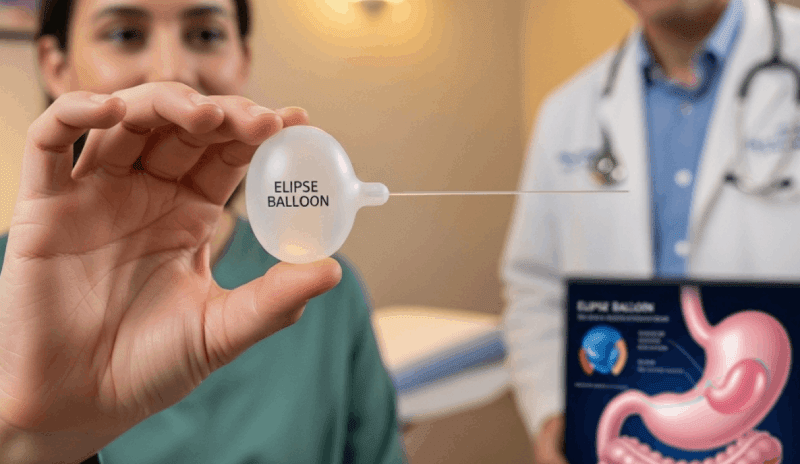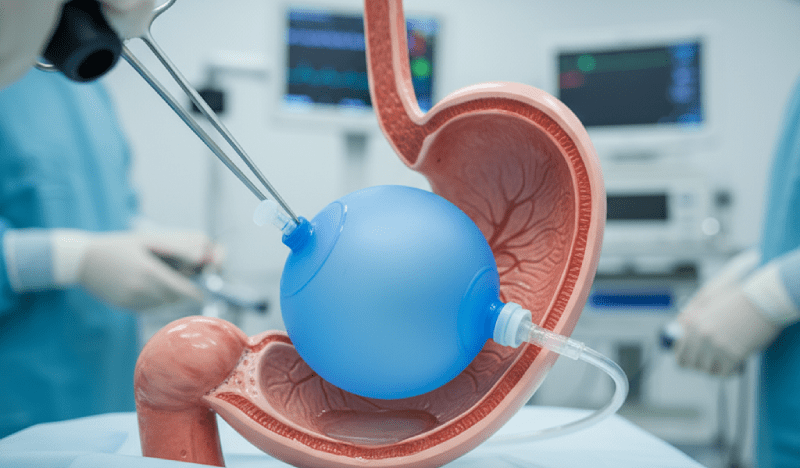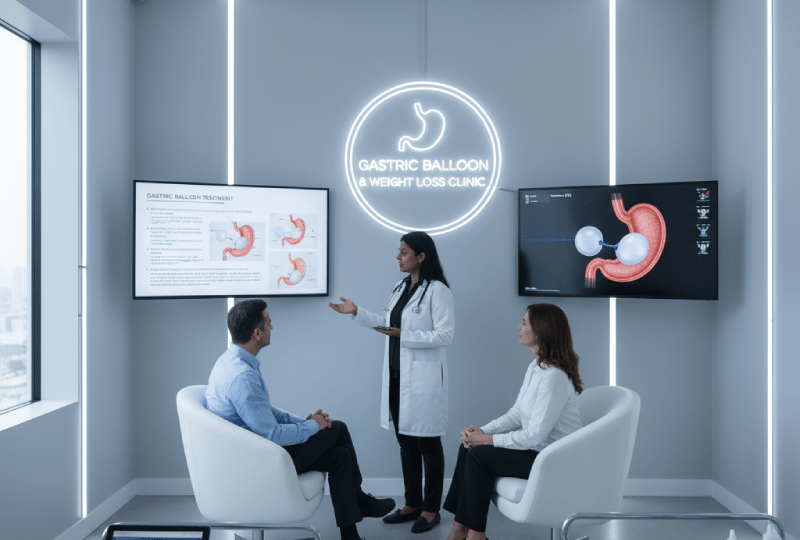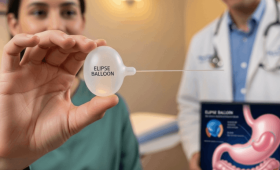What Is The Gastric Balloon And How Does It Work In The Body?
The gastric balloon is a non-surgical, temporary weight loss device. It is a procedure involving the placement of a soft, silicone balloon into the stomach, either endoscopically or in the form of a swallowable capsule, and subsequently inflating it with sterile saline solution to a certain volume.
The balloon, once placed in the stomach, physically occupies space, reducing the stomach’s capacity and thereby helping the patient feel satiated with less food. The main purpose of the balloon is to create a “learning period” for the patient to achieve portion control and adopt healthy eating habits. The habits gained must be maintained even after the balloon is removed.
Why Are Kusadasi Gastric Balloon Prices Attractive?
Kusadasi is strategically located in the Aegean region for health tourism, offering high quality at economical prices for relatively short procedures like the gastric balloon. The lower cost of living and operating expenses in Turkey compared to European countries, combined with the foreign exchange rate advantage, ensures that patients can acquire balloons of the same quality and international certification as those in the West, but at significantly more affordable prices. Furthermore, many clinics offer comprehensive packages that include accommodation and transfers, allowing patients to know their total costs in advance and avoid surprise expenses.
Who Is A Suitable Candidate For Gastric Balloon Treatment?
The gastric balloon is a suitable treatment option for individuals who generally do not require surgical operations (like sleeve gastrectomy) but struggle to lose weight with diet and exercise. Ideal candidates are individuals with a Body Mass Index (BMI) between 27 and 40. Suitable candidates are those who do not have serious stomach issues such as stomach ulcers, a large hiatal hernia, or a history of stomach surgery, whose chronic illnesses are under control, and who have the motivation to strictly adhere to the post-procedure diet program.
How Is The Gastric Balloon Procedure Performed And How Long Does It Take?
The gastric balloon procedure is generally performed using two different methods. Endoscopic placement, the most common method, takes 15-20 minutes under light sedation; the balloon is guided into the stomach with an endoscope and inflated with sterile liquid. The other method involves swallowable balloon systems, which are capsules swallowed by the patient and do not require surgical intervention; this balloon is checked under X-ray and inflated. Both methods are incision-free and stitch-free. After the procedure, the patient is kept under observation for 1-2 hours until the effect of the sedation wears off and is discharged on the same day.
Is Anesthesia Used During The Gastric Balloon Procedure?
Yes, light sedation (a conscious twilight state) is generally used during the gastric balloon procedure to ensure patient comfort and prevent any feeling of discomfort. Sedation during endoscopic balloon placement ensures the patient is in a state of deep relaxation throughout the procedure, feels no pain, and does not remember the operation. Sedation is usually not necessary for the swallowable balloon application, but a local anesthetic spray may be used for patient comfort while the balloon is checked and inflated under X-ray. Sedation is an important factor that makes the procedure safe and comfortable.
How Long Does The Gastric Balloon’s Effect Last?
The duration of the gastric balloon’s effect varies depending on the type of balloon used. The most common balloons on the market are typically designed to last for 6 months and 12 months. The 6-month balloons are removed sooner, while the 12-month balloons stay in the stomach longer, offering more opportunity for weight loss. Swallowable balloons generally deflate spontaneously and pass naturally out of the body after a period of 4 months. Regardless of the duration, this time is a critical window for the patient to radically change their eating habits.

How Much Weight Can Be Lost On Average With The Gastric Balloon?
The average amount of weight that can be lost with the gastric balloon depends on the patient’s initial body weight, BMI value, and most importantly, their adherence to diet and lifestyle changes. During the time the balloon is in the stomach, the goal is for patients to typically lose 10% to 25% of their total body weight. For example, a patient weighing 100 kg can lose an average of 10 to 25 kg. These results depend not only on the physical effect of the balloon but also on how strictly the patient adheres to the low-calorie, protein-rich diet program supported by a dietitian.
Is Weight Regain Possible After The Balloon Is Removed?
Unfortunately, if the patient does not maintain the healthy habits they acquired during the weight loss process after the gastric balloon is removed, weight regain is possible. The balloon is only a supportive tool and a creator of fullness. Once removed, the stomach volume returns to normal, and the patient must maintain portion control through their own discipline. The secret to preventing weight regain is for the routines learned while the balloon was in place—smaller portions, slow eating, and regular exercise—to become a permanent lifestyle.
What Are The Possible Side Effects of the Gastric Balloon?
The most common side effects observed in the first days after the gastric balloon procedure are nausea, vomiting, cramping, and a feeling of stomach spasms, resulting from the stomach attempting to adapt to the balloon. These symptoms usually intensify within the first 3 to 7 days and then gradually decrease. Medication is administered during this period to increase patient comfort. Rarer risks include deflation of the balloon, stomach ulcers, or the risk of intestinal obstruction; however, these risks are very low with modern balloons and under expert medical supervision.
How Should I Eat In The First Few Days After The Procedure?
The first few days after the gastric balloon procedure are the strictest period for the diet to acclimate the stomach to the balloon and minimize possible nausea. Only clear liquids (water, unsweetened tea, fat-free broth) should be consumed for the first 3 days. Over the next 4 days, pureed, protein-rich, and low-fat foods (yogurt, scrambled eggs, pureed soups) are gradually introduced. Hard foods, spicy, acidic, and carbonated drinks must be strictly avoided during the first week after the procedure. This transition period is vital for protecting the stomach and achieving a successful diet start.
How Safe Is The Gastric Balloon Procedure?
The gastric balloon procedure is considered a much safer and lower-risk procedure compared to weight loss surgery. The placement and removal of the balloon are done using an endoscopic method, which does not require a surgical incision. The risk of serious complications is quite low. Factors increasing safety include the experience of the gastroenterologist placing the balloon, the use of internationally approved (FDA/CE) balloon brands, and a detailed check of the patient’s health status before the procedure. The entire process is managed by prioritizing the patient’s comfort and safety.
Who Is Not Suitable For Gastric Balloon Treatment (Contraindications)?
Gastric balloon treatment is not suitable for individuals with certain medical conditions. Major contraindications include a history of stomach or bowel surgery, large hiatal hernia, active stomach ulcer or gastritis, inflammatory bowel diseases like Crohn’s disease, and eating disorders (bulimia). Furthermore, if the patient is pregnant or planning to become pregnant, this constitutes an obstacle. Such conditions are definitively identified through endoscopic examination and medical assessments performed before the procedure and prevent the treatment.
How Is The Balloon Removal Procedure Performed And Is It Painful?
The gastric balloon removal procedure, similar to the placement procedure, is performed endoscopically and under light sedation. The removal of the balloon usually begins with the aspiration of the liquid used to inflate the balloon via the endoscope. The deflated balloon is then gently pulled out of the stomach through the mouth with the aid of the endoscope. Since sedation is used, the patient does not feel any pain or discomfort, and the procedure takes about 20-30 minutes. After the removal procedure, the patient can return to their daily life after a short rest period.
What Happens If The Balloon Deflates Or Bursts In The Stomach?
The risk of deflation or rupture in modern gastric balloons is quite low. However, if such a situation rarely occurs, the liquid inside the balloon usually contains a blue or green dye (methylene blue). If the balloon deflates, this dye is absorbed by the intestines, and the patient’s urine turns blue or green. This alerts the patient that they must immediately apply to the clinic. Balloon deflation requires urgent endoscopic removal to prevent the risk of intestinal obstruction. Swallowable balloons are designed to deflate and pass naturally after a certain period.
How Should The Diet Be Continued After The Balloon Is Removed?
The diet after the gastric balloon is removed represents the transition to the weight maintenance phase and focuses on making the habits acquired while the balloon was in the stomach permanent. Since the stomach volume returns to normal after the removal procedure, portions should be gradually increased over the first few weeks, and the patient must still adhere to the slow eating rule. The dietitian will create a sustainable, balanced, high-protein, and high-fiber nutrition plan specifically for this stage. The permanence of the weight loss process depends on maintaining disciplined eating even without the balloon.
How Many Days Should I Stay In Kusadasi In Total For Gastric Balloon Treatment?
The gastric balloon procedure is generally an outpatient treatment that does not require hospitalization. For international patients to have a safe and stress-free process, the stay in Kusadasi is usually recommended to be a total of 3 to 4 days. This duration is sufficient for arrival in Kusadasi, detailed medical check-ups and consultation, balloon placement, a check-up the day after, and monitoring of possible initial side effects. This short period allows patients to return to their normal lives immediately after treatment while also enabling them to benefit from the comfort and rest opportunities the city offers.
What Is The Biggest Advantage Of The Gastric Balloon Procedure?
The biggest advantage of the gastric balloon procedure is that it does not require a surgical incision or a permanent anatomical change. This is an ideal solution for patients who do not want to take the risks of bariatric surgery or whose BMI is not high enough for surgery. The procedure is completed quickly under sedation and does not require hospitalization. The feeling of fullness provided by the balloon during its time in the stomach creates valuable time for the patient to learn portion control and receive nutrition education. Its reversibility makes the balloon a safe and flexible method.

How Is Nausea Managed In The First Days After The Procedure?
Nausea experienced in the first days after the gastric balloon is placed is a natural reaction of the stomach to the balloon and can be effectively managed with medication. Your clinic will prescribe strong anti-emetic (anti-nausea) and antispasmodic medications specially designed to minimize nausea and cramps. The regular use of these medications reduces the intensity of the nausea. Additionally, the patient’s consumption of plenty of fluids, drinking in small sips, and strictly avoiding solid foods for the first 3 days play a critical role in managing nausea.
Can I Return To Work Immediately After The Gastric Balloon Is Placed?
Returning to work immediately after the gastric balloon is placed is generally not recommended. Although the procedure is not surgery, the patient should be allowed at least 2 to 3 days of rest to fully recover from the effects of sedation and for the stomach to adapt to the balloon. These first days are when side effects like nausea and cramps are most intense. The patient can return to non-strenuous work starting around the 3rd or 4th day after completing this initial adaptation process. However, heavy physical activities and long periods of standing should be avoided during this time.
Which Balloon Brands Are Used In Gastric Balloon Treatment?
The brand and quality of the balloon used are of great importance for the success and safety of gastric balloon treatment. Competent clinics in Kusadasi generally prefer internationally recognized and FDA/CE approved balloon brands. These brands are known for their durability, low risk of deflation, and biocompatibility. Which balloon brand (such as Elipse, Orbera, Spatz, etc.) will be used in the clinic is determined according to the duration the balloon will remain in the stomach, the patient’s preference, and the physician’s expertise. A quality balloon enhances the comfort and reliability of the treatment process.
What Is The Main Difference Between The Gastric Balloon And Gastric Botox?
The gastric balloon and gastric Botox are non-surgical weight loss support methods, but they work with different mechanisms. The gastric balloon physically occupies space in the stomach and provides volumetric satiety. Gastric Botox, on the other hand, temporarily slows down the contraction of the stomach muscles, prolonging the time food stays in the stomach, and creates functional satiety. The balloon’s effect provides a more noticeable volume restriction, while Botox is less invasive and does not require removal (its effect wears off naturally). The BMI value and the expected amount of weight loss determine which method is more suitable.
What Is The Maximum Time The Balloon Must Stay In The Body?
Although it varies by the type of gastric balloon, every balloon has a specific maximum duration it must stay in the stomach. This duration is determined by considering the durability of the balloon’s material and its resistance to the acidic environment of the stomach. For example, the maximum duration for 6-month balloons is generally 6-7 months, and for 12-month balloons, it is 12-13 months. The balloon staying in the stomach longer than this maximum duration increases the risk of deterioration of the balloon’s structure, deflation, or damage to the stomach wall. Therefore, it is vital that the balloon is removed under medical supervision before its expiry date.
When Can Sports And Exercise Be Started After Gastric Balloon Treatment?
Sports and exercise routines should be resumed gradually after the gastric balloon is placed. The first 3 to 5 days should be set aside for rest for the stomach’s adaptation to the balloon, with only light walking allowed. Moderate-intensity exercises (brisk walking, light cardio) can generally be started at the end of the first week. After stomach cramps or discomfort subside, which is usually 2 weeks later, more intense and weight-lifting sports can be resumed. Regular exercise accelerates the weight loss process and supports the balloon’s effectiveness, but overdoing it during the initial adaptation period should be avoided.
What Preparations Are Required Before The Balloon Placement Procedure?
Preparations must be made before the balloon placement procedure to check the patient’s stomach health and general condition. Patients may be instructed by the doctor to start taking certain medications (especially blood thinners and stomach protectors) before the procedure. Solid food intake must be stopped at least 8 hours, and liquid intake at least 4 hours before the procedure (fasting is mandatory). Additionally, smoking and alcohol consumption should be stopped some time before, as instructed by the doctor. Comfortable clothes should be chosen for the day of the procedure, and having a companion is recommended.
Does The Gastric Balloon Create A Permanent Change In The Body?
No, the gastric balloon does not create a permanent anatomical change in the body. The entire effect of the balloon is limited to temporarily occupying space in the stomach and providing a feeling of fullness. When the balloon’s time is up, it is removed endoscopically, and the structure and function of the stomach return entirely to their former state. The balloon’s purpose is not to create a permanent physiological restriction but to offer a behavioral change window to help the patient gain new and permanent healthy eating habits. This reversible feature creates a significant difference compared to surgical methods.
Why Should The Balloon Be Checked Before Removal?
Checking the balloon before it is removed from the stomach is a critical step for the safety of the procedure and the prevention of possible complications. An endoscopic examination is performed immediately before the removal procedure. This examination checks the integrity of the balloon and whether there is any wear or deflation on its surface. Additionally, it is checked whether any damage (such as ulcers or irritation) has occurred to the stomach wall due to the balloon remaining in the stomach for a long time. This check is mandatory for safely deflating and removing the balloon.

What Is Included In The Gastric Balloon Packages In Kusadasi?
Health centers in Kusadasi typically offer comprehensive services in their gastric balloon packages for international patients. Standard inclusions are: the balloon itself (chosen brand), endoscopic placement/removal fees, sedation and anesthesiologist fees, hospital/clinic usage fee, medications used after balloon placement, airport and local transfers, and generally 3-4 nights of accommodation. Furthermore, dietitian follow-up and translation services are usually an integral part of the package. It is important to clarify all items in advance to ensure the patient does not incur extra charges.
What Medications Should Be Used During The Treatment Period?
A range of medications is mandatory after the gastric balloon is placed to increase the patient’s comfort and protect the stomach. These typically include: anti-emetic (anti-nausea and anti-vomiting) medications, stomach protector (PPI) medications that balance stomach acid and protect the stomach wall, and antispasmodic/painkiller medications to relieve possible cramps and pain. These medications must be used regularly, especially during the first week when the stomach adapts to the balloon. All medications must be prescribed by the physician specifically for the patient’s condition.
Does Stomach Acid Problem Occur After The Gastric Balloon Procedure?
It is possible for some patients to experience temporary problems like acid reflux or heartburn after the gastric balloon procedure, due to the pressure or irritation caused by the balloon. This condition may be due to the balloon putting pressure on the stomach valve (sphincter) or irritation of the stomach wall. To prevent and manage such problems, physicians generally prescribe stomach protector (PPI) medications to be used long-term before and after balloon placement. Additionally, avoiding lying down immediately after eating, consuming small portions, and avoiding spicy/acidic foods also helps alleviate these symptoms.
What Is The Swallowable Gastric Balloon And How Is It Different From The Endoscopic Balloon?
The swallowable gastric balloon is an innovative type of balloon that does not require endoscopy or anesthesia for placement and removal. The balloon comes in the form of a capsule swallowed by the patient with the help of water. Once it reaches the stomach, it is inflated via a thin catheter applied externally, and this process is checked under X-ray. The biggest difference between the swallowable balloon and the endoscopic balloon is that it usually deflates spontaneously after 4 months and passes naturally out of the body with stool; this eliminates the removal procedure. This balloon is an ideal option for patients who have a fear of endoscopy or do not want to receive anesthesia.
Are There Smoking And Alcohol Restrictions Before The Gastric Balloon Procedure?
Yes, serious restrictions on smoking and alcohol consumption are mandatory before and after the gastric balloon procedure. Stopping smoking and alcohol at least one week before the procedure is compulsory to reduce the risk of sedation and protect the stomach wall from possible irritation. After the procedure, smoking increases stomach acid, aggravating the nausea and stomach discomfort the balloon may cause. Alcohol, in addition to being high in calories, can interfere with medications used during the treatment process. Therefore, avoiding these substances is mandatory for both treatment comfort and weight loss success.
How Is The Weight Loss Process Monitored After The Balloon Is Placed?
The weight loss process after the gastric balloon is placed is regularly monitored by the clinic’s dietitians and coordinators. Patients generally provide information about their weight loss, eating habits, and any difficulties they experience through remote consultation (tele-consultation) at monthly or bi-weekly intervals. In this follow-up process, the patient’s motivation is increased, possible dietary mistakes are corrected, and the nutrition plan is updated. Regular follow-up is vital for ensuring maximum weight loss while the balloon is effective and supporting the permanence of healthy habits.
What Is The Long-Term Success Of Gastric Balloon Treatment?
The long-term success of gastric balloon treatment depends on the sustainability of the lifestyle after the balloon is removed. By the end of the period the balloon is in the stomach, most patients have lost a significant portion of their excess weight. However, patients who maintain healthy portion control, low-calorie eating, and regular exercise after the balloon is removed can maintain the weight loss. Studies show that 70% of successful patients maintain a significant portion of their weight loss for 1-2 years. Long-term success relies on the patient’s own discipline and continuous relationship with the dietitian.
What Happens If I Become Pregnant While Using The Gastric Balloon?
Becoming pregnant while the gastric balloon is in place carries a serious risk, and this situation must be immediately reported to the physician. The volume restriction caused by the balloon in the stomach and its effect on nutrient absorption can prevent the adequate nutrient intake necessary for the healthy development of the fetus. Additionally, nausea and vomiting that may occur during pregnancy can be much harder to manage with the balloon in place. Therefore, if pregnancy is suspected while the balloon is inserted, the balloon may need to be removed endoscopically as soon as possible. This is a pre-cautionary situation that must be carefully considered for the patient’s health.
Can I Drive A Car After The Gastric Balloon Procedure?
It is absolutely not recommended to drive a car immediately after the gastric balloon procedure. Since the procedure is performed under light sedation (conscious sleep), the effect of the sedation can continue for several hours after the procedure and negatively affect the patient’s reflexes and concentration ability. This increases the risk of traffic accidents. Therefore, the patient must use the transfer service accompanied by a companion when visiting the clinic or hotel after the procedure. Patients can start driving a car the next day when the effect of the sedation has completely worn off and they feel fully alert.
What Supplements Should Be Used With The Gastric Balloon?
Since the patient’s food intake is restricted while using the gastric balloon, it is important to use additional supplements to prevent possible vitamin and mineral deficiencies. Dietitians generally recommend: protein supplements for adequate muscle mass, B vitamins (especially B12) for hair and nail health, Vitamin D, and iron supplements. The use of these supplements supports healthy weight loss while ensuring the body’s essential functions are not disrupted. All supplements must be taken only upon the advice and direction of a specialist physician or dietitian.
What Stomach Medications Should Be Used Before The Procedure?
It is generally mandatory to use stomach protector (Proton Pump Inhibitors – PPI) medications before the gastric balloon procedure to reduce the stomach’s acid level and lessen the risk of irritation and ulcers that might occur due to the balloon. Physicians generally start these medications about a week before the balloon placement procedure and ask for them to be continued regularly throughout the time the balloon remains in the stomach. These medications play a critical role in protecting the stomach wall, thereby increasing the safety and comfort of the balloon. The regular use of such medication is an integral part of the treatment plan.

Is Overseas Travel Safe After The Gastric Balloon Procedure?
Overseas travel after the gastric balloon procedure is generally safe, but it is important that the patient feels ready to travel. The first 48 hours after balloon placement are the period when nausea and stomach cramps are most intense; therefore, spending this time resting in Kusadasi is best. Travel can generally be undertaken 2 to 3 days after the procedure. The gastric balloon does not cause any problems during air travel; however, the patient is advised to drink plenty of water and keep their anti-nausea medications with them to increase their comfort.
What Is The Age Limit For Gastric Balloon Treatment?
The lower age limit for gastric balloon treatment is generally over 18 years old, and the upper age limit depends on the patient’s general health condition being suitable for sedation. Support for weight loss for patients under 18 is usually only considered with very specific medical justification and parental consent. There is no definitive rule for the upper age limit; elderly patients who are in good cardiovascular and pulmonary health and can tolerate sedation may also receive gastric balloon treatment. What is important is the physiological health and adaptability to the treatment rather than chronological age.
Does Bad Breath Occur After Gastric Balloon Treatment?
It is possible to experience temporary bad breath (halitosis) after gastric balloon treatment. There can be several reasons for this: First, the slowing of the stomach’s emptying time and food residues remaining in the stomach can cause odor. Second, the development of ketosis (a byproduct of fat burning) due to insufficient nutrition and low fluid intake in the first days. This condition can be largely prevented by regular oral hygiene (brushing teeth, cleaning the tongue) and consuming plenty of water. As the diet returns to normal and the stomach adjusts to the balloon, this problem usually disappears.
Does Dietitian Support Continue After The Balloon Is Removed?
Yes, dietitian support continuing even after the gastric balloon is removed is vital for the weight loss to become permanent. The removal of the balloon is not the end of the weight loss journey but the beginning of the weight maintenance phase. The dietitian creates a plan during this stage that allows the patient to gradually increase their portions while keeping calorie intake under control. Long-term follow-up and counseling services minimize the risk of the patient returning to old eating habits and help maintain the successful results achieved.
Which Specialization Does The Balloon Placement Procedure Fall Under?
The gastric balloon placement and removal procedures are endoscopic procedures and are generally performed by Gastroenterology specialists. These specialists have deep knowledge and experience in digestive system anatomy and endoscopic techniques. The correct positioning, inflation of the balloon, and management of possible stomach irritation are the responsibility of this specialization. The patient’s safety under sedation is managed by an Anesthesiology specialist. Clinics in Kusadasi collaborate with certified gastroenterologists to perform these procedures.
Is Endoscopy Mandatory Before The Balloon Placement Procedure?
Yes, diagnostic endoscopy is mandatory before the endoscopic balloon placement procedure. This pre-endoscopy is done to check for any condition that might prevent the placement of the gastric balloon (large hiatal hernia, active ulcer, inflammation, etc.). To safely place the gastric balloon and prevent any risk of complications, it must be ensured that the inside of the stomach is clean and healthy. If a problem is detected during this examination, that problem must be treated first, and then the balloon placement procedure can be planned.
What Are The Reasons For Failure Of The Gastric Balloon?
The main reason for the failure of gastric balloon treatment is the patient’s inability to comply with the diet program and lifestyle changes. Although the balloon provides physical restriction, if the patient continues to consume high-calorie liquid foods (carbonated drinks, sweets, alcohol), weight loss may not occur. Another rare reason is the balloon deflating early or the stomach showing excessive sensitivity to the balloon, making severe nausea and vomiting uncontrollable. Failure usually results from behavioral non-compliance rather than a surgical problem.
Does The Gastric Balloon Cause Damage To Surrounding Tissues?
Although the gastric balloon is placed to be in contact with the inner surface of the stomach (mucosa), its silicone structure is biocompatible and does not cause permanent damage to surrounding tissues. The only effect the balloon causes in the stomach is volumetric restriction and pressure. Rarely, balloons that remain for a long time or are placed improperly can cause temporary irritation or erosion on the stomach wall; however, these conditions can usually be treated with stomach protective medications. After the balloon is removed, the stomach tissue heals quickly, and no permanent damage occurs.
What Conditions Are Emergency Signals After The Balloon Is Placed?
Some conditions after the gastric balloon is placed can be signals requiring urgent medical intervention. These include severe and uncontrollable vomiting, severe stomach cramps or pain lasting more than a few days, blood in the stool, or urine turning blue or green (a sign of balloon deflation). If such symptoms occur, the patient must immediately call the clinic or emergency service. Early intervention is vital for preventing possible complications (e.g., intestinal obstruction).
Is Interpreter Service Provided For Patients From Abroad?
Yes, health tourism centers in Kusadasi provide professional translation services as a standard to ensure international patients go through their treatment processes smoothly. Interpreters assist the patient in communicating with the physician and other clinic staff at every stage, such as consultation, during the procedure, and when giving post-discharge instructions. This service eliminates the language barrier, ensuring the patient receives the most accurate information about the process, feels secure, and fully complies with the treatment.
This detailed set of 35 questions and answers provides the comprehensive guide you need about Gastric Balloon treatment and pricing in Kusadasi. To start your non-surgical weight loss journey with high standards and confidence, and to plan your entire travel organization stress-free, we strongly recommend contacting Cure Holiday, who are experts in health tourism. They will be delighted to offer you the most suitable price guarantee and guide you through the process.


